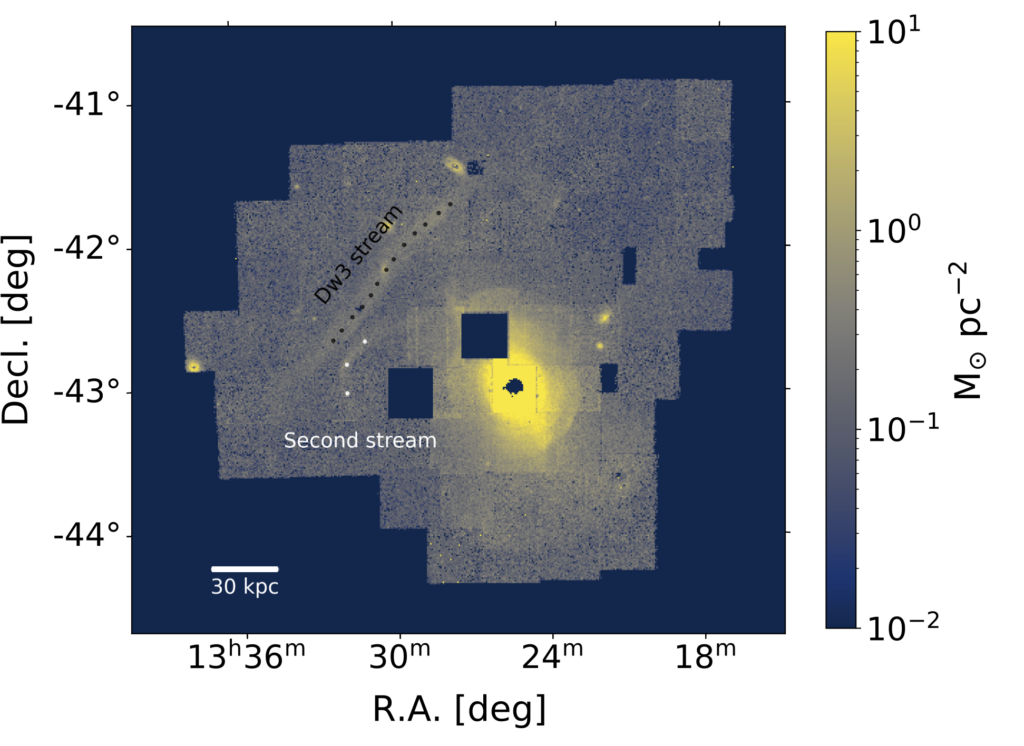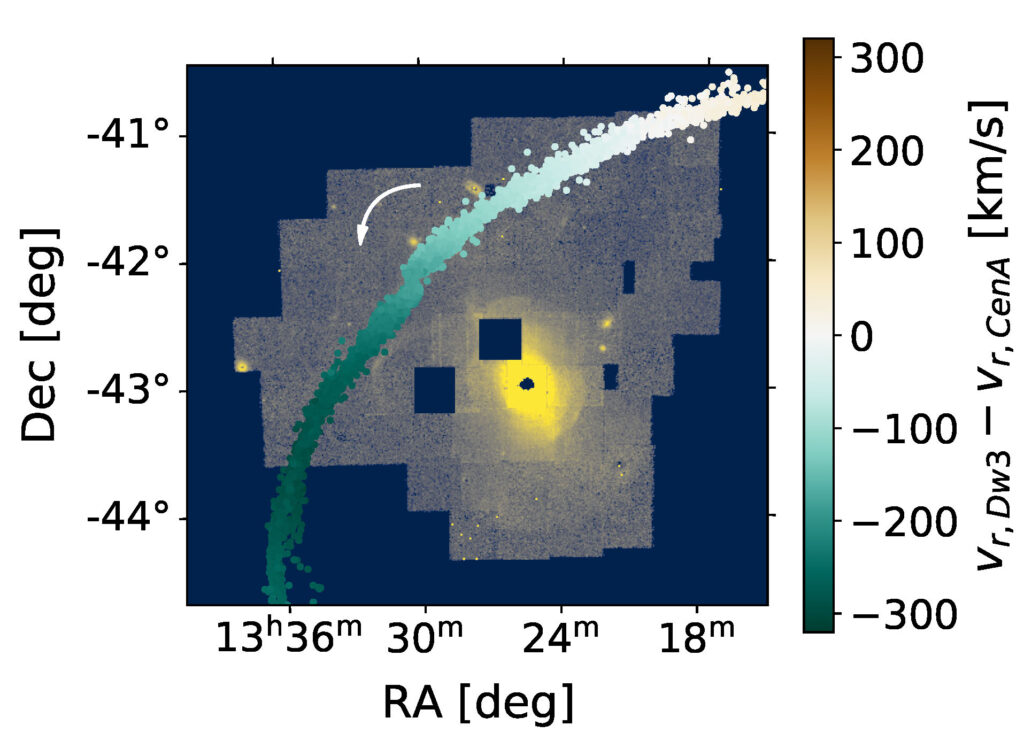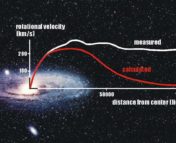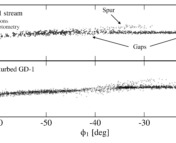Title: Mapping Dark Matter with Extragalactic Stellar Streams: the Case of Centaurus A
Authors: Sarah Pearson, Adrian M. Price-Whelan, David W. Hogg, Anil C. Seth, David J. Sand, Jason A. S. Hunt, Denija Crnojevic
First Author’s Institution: Center for Cosmology and Particle Physics, Department of Physics, New York University, 726 Broadway, New York, NY 10003, USA
Status: Submitted to AAS Journals [open access]
Have you looked at leaves that fall into a river and swirl around in the current? It’s hard to see where water flows, but leaves are good tracers of this motion. If you are experienced, you might be able to infer the underwater terrain from the water current. A similar phenomenon happens when a dwarf galaxy falls into a massive galaxy. Stars are dispersed from the dwarf galaxy and stretch out into a stream. Stars are easy to observe and they are good tracers of the invisible dark matter in a galaxy, which governs their motion. As explained in this astrobite, astronomers can use stellar streams to learn about dark matter (DM) in galaxies.
In the Milky Way, stellar streams have been used to infer DM distribution and even DM substructure. We can model these stars in detail because we can observe their full 3D positions and velocities. This is much harder to do for external galaxies, where distances are difficult to obtain and velocities even harder. What can we learn from the stellar streams of external galaxies? The authors of today’s paper turn to Cen A (NGC5128), a nearby massive galaxy.

Data and Method
Cen A hosts a known stellar stream associated with its dwarf satellite galaxy Dw3. Fig. 1 shows the stellar density in the outer halo of Cen A. Two streams are visible from this map, but we will focus on the Dw3 stream. Since these streams are around 4 Mpc away, the authors only use the locations of the stream in the sky, as indicated by the black points in Fig 1. The goal is to use this information to find the orbit of the progenitor dwarf galaxy (Dw3), which can then constrain the DM distribution of the central massive galaxy (Cen A).
In order to model this stellar stream, the authors develop a new stream-fitting technique. Control points are placed by eye to indicate the known location of the Dw3 stream. The inputs to this model are the control points and the radial velocity of the progenitor (Dw3). To calculate the orbit of Dw3, we also need to input the gravitational potentials of both Cen A and Dw3. But isn’t the gravitational potential something we want to find out with the modeling? That’s why the authors start with a reasonable fiducial potential, and then explore what happens if you vary it.
Given the known inputs, the authors simulate how stars are dispersed from the progenitor and form a stream. They use a publicly available code gala to integrate the orbit of Dw3 in the potential of Cen A. The code releases stars from Dw3 at each time step and follows where they go under the combined gravitational forces of Dw3 and Cen A. The resulting stellar stream is compared to the control data points, and the best-fitting model has to match all of them. Then, the authors also run a more accurate N-body simulation with the same initial setup as the best-fit model to make sure that gala results are reliable.
Results

Fixed Cen A halo: from the fiducial model, the authors find a range of models that can reproduce the shape of the Dw3 stream. The best-fit model is shown in Fig. 2, as projected on sky. The stream looks straight on sky, and the best fit orbits have high velocity in the direction of the stream and low velocity in the perpendicular direction. Makes sense. What happens when you vary the Cen A halo?
Degeneracy: We are only matching the shape of the stream on sky, which is fundamentally not enough information to uniquely constrain its history. The reason is illustrated in Fig. 3. If you half the mass of both the host and the satellite dwarf, the orbital velocities will be lower and the stars disperse more slowly. But if you wait longer, the satellite will show the exact same disruption and the resulting stream (shown in the top two panels of Fig. 3) will look the same. Lacking the ability to observe this stream 6 billion years ago, we can only observe the stream at t=0 in the bottom plots. If we only have spatial position of the stream, and we don’t know how long it has been disrupting, then we won’t be able to distinguish between high mass and low mass potentials. That’s a problem since that was our goal in the beginning!

How to break this degeneracy: The difference between these two scenarios is in radial velocity and distance. Even though the shape of the streams look identical in Fig. 3, the color bar shows that they have different radial velocities. This is a direct result from the orbital velocity of the progenitor dwarf galaxy, which depends on the host halo mass. Even though radial velocity of the stream has not been measured, even observing part of the stream can help pin down the mass of the host galaxy. The authors in this paper identify some readily available instruments that can take this measurement, and it’s up to observers to point the telescopes at Dw3!
Outlook
Future telescopes like the Vera Rubin Observatory and the Roman Space Telescope will be able to detect thousands of extragalactic stellar streams. The tools built by today’s authors will pave the way for exploring dark matter halos of all those galaxies!
Astrobite edited by Benjamin Cassese
Featured image credit: Sarah Pearson




